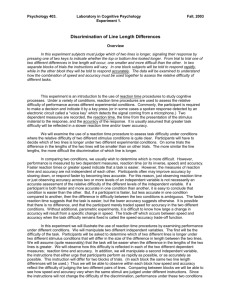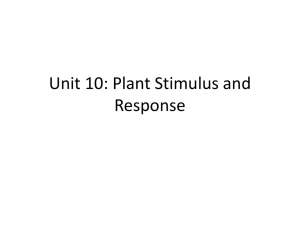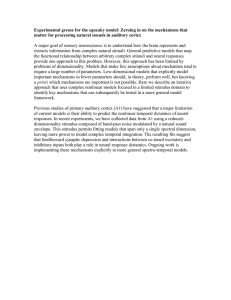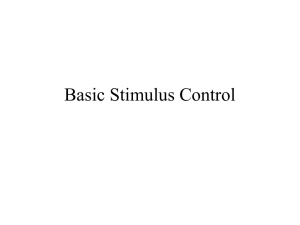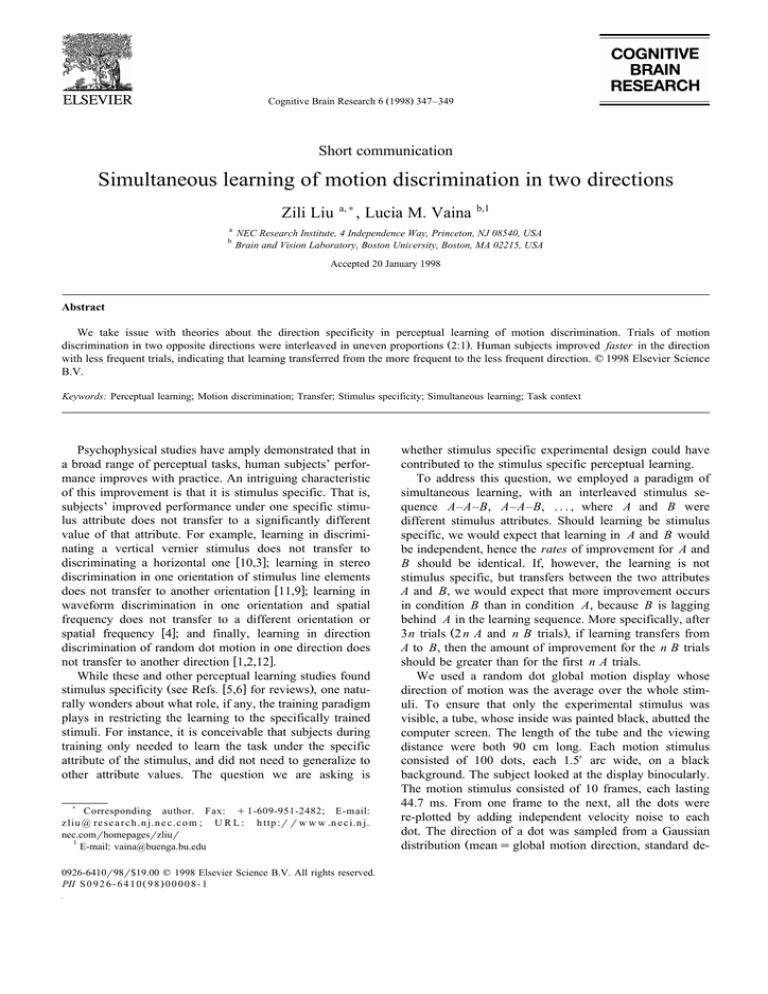
Cognitive Brain Research 6 Ž1998. 347–349
Short communication
Simultaneous learning of motion discrimination in two directions
Zili Liu
a
b
a,)
, Lucia M. Vaina
b,1
NEC Research Institute, 4 Independence Way, Princeton, NJ 08540, USA
Brain and Vision Laboratory, Boston UniÕersity, Boston, MA 02215, USA
Accepted 20 January 1998
Abstract
We take issue with theories about the direction specificity in perceptual learning of motion discrimination. Trials of motion
discrimination in two opposite directions were interleaved in uneven proportions Ž2:1.. Human subjects improved faster in the direction
with less frequent trials, indicating that learning transferred from the more frequent to the less frequent direction. q 1998 Elsevier Science
B.V.
Keywords: Perceptual learning; Motion discrimination; Transfer; Stimulus specificity; Simultaneous learning; Task context
Psychophysical studies have amply demonstrated that in
a broad range of perceptual tasks, human subjects’ performance improves with practice. An intriguing characteristic
of this improvement is that it is stimulus specific. That is,
subjects’ improved performance under one specific stimulus attribute does not transfer to a significantly different
value of that attribute. For example, learning in discriminating a vertical vernier stimulus does not transfer to
discriminating a horizontal one w10,3x; learning in stereo
discrimination in one orientation of stimulus line elements
does not transfer to another orientation w11,9x; learning in
waveform discrimination in one orientation and spatial
frequency does not transfer to a different orientation or
spatial frequency w4x; and finally, learning in direction
discrimination of random dot motion in one direction does
not transfer to another direction w1,2,12x.
While these and other perceptual learning studies found
stimulus specificity Žsee Refs. w5,6x for reviews., one naturally wonders about what role, if any, the training paradigm
plays in restricting the learning to the specifically trained
stimuli. For instance, it is conceivable that subjects during
training only needed to learn the task under the specific
attribute of the stimulus, and did not need to generalize to
other attribute values. The question we are asking is
)
Corresponding author. Fax: q 1-609-951-2482; E-mail:
z liu @ re s e a rc h .n j.n e c .c o m ; U R L : h ttp :r r w w w .n e c i.n j.
nec.comrhomepagesrzliur
1
E-mail: vaina@buenga.bu.edu
0926-6410r98r$19.00 q 1998 Elsevier Science B.V. All rights reserved.
PII S 0 9 2 6 - 6 4 1 0 Ž 9 8 . 0 0 0 0 8 - 1
whether stimulus specific experimental design could have
contributed to the stimulus specific perceptual learning.
To address this question, we employed a paradigm of
simultaneous learning, with an interleaved stimulus sequence A–A–B, A–A–B, . . . , where A and B were
different stimulus attributes. Should learning be stimulus
specific, we would expect that learning in A and B would
be independent, hence the rates of improvement for A and
B should be identical. If, however, the learning is not
stimulus specific, but transfers between the two attributes
A and B, we would expect that more improvement occurs
in condition B than in condition A, because B is lagging
behind A in the learning sequence. More specifically, after
3n trials Ž2 n A and n B trials., if learning transfers from
A to B, then the amount of improvement for the n B trials
should be greater than for the first n A trials.
We used a random dot global motion display whose
direction of motion was the average over the whole stimuli. To ensure that only the experimental stimulus was
visible, a tube, whose inside was painted black, abutted the
computer screen. The length of the tube and the viewing
distance were both 90 cm long. Each motion stimulus
consisted of 100 dots, each 1.5X arc wide, on a black
background. The subject looked at the display binocularly.
The motion stimulus consisted of 10 frames, each lasting
44.7 ms. From one frame to the next, all the dots were
re-plotted by adding independent velocity noise to each
dot. The direction of a dot was sampled from a Gaussian
distribution Žmean s global motion direction, standard de-
348
Z. Liu, L.M. Vainar CognitiÕe Brain Research 6 (1998) 347–349
Fig. 1. The schematic of the experimental procedure for one trial: fixation
mark ‘q,’ the first motion, fixation, the second motion, and the fixation.
The subject was to decide whether the two stimuli moved in the same or
different directions. Feedback was provided.
viation Ž s 1 . s 58.. The speed of each dot was 3.8X arc plus
the absolute value of a random number from a Gaussian
distribution Žmean s 0, s 2 s 1.5X arc.. The stimuli were
displayed on a Macintosh Centris 650s monitor in a circular aperture 88 in diameter. These experimental parameters
were chosen in pilot studies so that the task was not too
difficult and, at the same time, there was sufficient room
for improvement.
The sequence of the trials followed the pattern of
A–A–B, A–A–B, PPP . In each trial, two consecutive
motion stimuli were presented, whose global directions
were either identical or differed by 308. In an A trial, the
two directions were 1358 and 1658. In a B trial, they were
the opposite, i.e., 3158 and 3458. We used opposite motion
directions because previous studies found that learning in
one direction transferred least to its opposite direction
w1,2x. The A, B directions were counterbalanced across
subjects.
The subjects’ task was to decide in each trial whether
the two stimuli moved in the same or different directions.
They were instructed to respond as fast and as accurately
as possible. Fig. 1 shows one trial in the following sequence: the first motion, the fixation mark, the second
motion, and the fixation mark. The subject responded by
pressing one of two keys to indicate whether the two
motion directions were the same or different. Feedback for
incorrect responses was provided by a computer beep. This
completed one trial, and the next started automatically.
Author Z.L. and five naive subjects Žfive men, one
woman, 20–30 years of age. participated in the experiment. All subjects were right-handed, with normal or
corrected to normal vision, and used their right hands to
respond. Each subject took a total of 780 trials that lasted
for about 30 min. The subject was dark adapted and took
20 practice trials Žwith the same feedback. before the
experiment started.
Each subject’s discrimination index dX was calculated
for the first 260 A trials Ž A1 ., all the 260 B trials Ž B ., and
the second 260 A trials Ž A 2 . ŽFig. 2.. 2 Every subject’s dX
2
for B was higher than for A1. This difference was statistically significant Ž t Ž5. s 2.26, p - 0.05, two-tailed., suggesting that the amount of improvement during the same
number of trials was greater for B than for A. This
indicates a transfer from A to B, because the rate of
improvement for B was higher than for A.
The key manipulation of our study in this paper is the
paradigm of interleaved simultaneous learning, with unequal proportions of the two stimuli. The idea is that with
unequal number of trials of two different stimuli intermixed, the ‘minority’ Ž B . should have a faster learning
rate as long as learning transfers between the two directions. The null hypothesis is that learning is stimulus
specific, so that no learning transfers between the two, and
their learning rates should be identical Žsince the stimuli
are of the same difficulty..
The outcome of no transfer is predicted by the classic
study of motion discrimination in which learning is direction specific w1,2,12x. These studies further postulate that,
since learning is motion direction specific, the underlying
neural substrate responsible for learning is at the middle
temporal area ŽMT. where neurons are motion direction
selective. In this paper we took a different approach:
instead of asking ‘where has learning occurred?’, we
focused on characterizing conditions under which learning
is stimulus specific. More specifically, we asked whether
the task context constrains such specificity. In our simultaneous learning task, the result suggested that learning
transferred, when it was beneficial for the visual system to
generalize what was learned between two opposite directions. In other words, when learning one general direction
of motion, the visual system may not need to generalize to
other directions. When two directions are being learned,
the visual system may transfer what is learned between the
two directions whenever possible. We take caution and
X
It is not entirely clear why Subjects R.B. and S.V. had a larger d for
B than for A 2 . We speculate about two possibilities. Ž1. The difference
was due to noise, as data in perceptual learning are typically noisy both
between and within subjects. Ž2. Learning in motion discrimination for
opposite directions is not always perfectly symmetric, which we have
found in other studies as well w7,8x.
X
Fig. 2. The discrimination index d for each subject. ‘ A1 ’ represents the
first 260 trials of the A condition, and ‘B’ all the 260 B trials. The
second 260 trials of the A condition ‘ A 2 ’ are also included for compariX
son. Every subject’s d for B is greater than for A1.
Z. Liu, L.M. Vainar CognitiÕe Brain Research 6 (1998) 347–349
note that the A, B directions in this study were opposite to
each other, therefore our results finding transfer between
them may or may not generalize to other motion directions. After all, the visual system’s motion analysis has a
direction opponent organization. We speculate, however,
that our results are not limited to opposite motion directions, for two reasons. Ž1. The classic study in Ref. w1x
found no transfer whatsoever to opposite directions. In
fact, this was the singly most important reason that we
chose opposite directions in this study. Ž2. In other studies
w7,8x, generalization of perceptual learning was found between orthogonal directions. With this caution in mind, we
suggest that perceptual learning in motion discrimination
generalizes to other directions as long as the experimental
task is appropriate. Studies in perceptual learning should
consider both the nature of the stimuli and the nature of
the task.
Acknowledgements
We thank William Bialek, David Jacobs, Rob de Ruyter
van Stevenick, John Oliensis, and in particular, Pascal
Mamassian, for helpful discussions. This research was first
reported at the European Conference on Visual Perception
ŽECVP., Tubingen,
Germany, 1995. LMV was supported
¨
by NIH grant EY2R01-07861.
349
References
w1x K. Ball, R.A. Sekuler, Specific and enduring improvement in visual
motion discrimination, Science 218 Ž1982. 697–698.
w2x K. Ball, R. Sekuler, Direction-specific improvement in motion discrimination, Vision Res. 27 Ž6. Ž1987. 953–965.
w3x M. Fahle, S. Edelman, Long-term learning in Vernier acuity: effects
of stimulus orientation, range and of feedback, Vision Res. 33 Ž3.
Ž1993. 397–412.
w4x A. Fiorentini, N. Berardi, Learning in grating waveform discrimination: specificity for orientation and spatial frequency, Vision Res. 21
Ž1981. 1149–1158.
w5x C.D. Gilbert, Neuronal dynamics and perceptual learning, Curr.
Biol. 4 Ž1994. 627–629.
w6x A. Karni, The acquisition of perceptual and motor skills: a memory
system in the adult human cortex, Cogn. Brain Res. 5 Ž1996. 39–48.
w7x Z. Liu, Learning a visual skill that generalizes across orientations.
Proc. Natl. Acad. Sci. USA, Žto appear., 1998.
w8x Z. Liu, D. Weinshall, Perceptual learning transfers—Learning is
getting much faster, Abstr. Psychonomic Soc. 2 Ž1997. 1.
w9x A.J. O’Toole, D. Kersten, Learning to see random-dot stereograms,
Perception 21 Ž1992. 227–243.
w10x T. Poggio, M. Fahle, S. Edelman, Fast perceptual learning in visual
hyperacuity, Science 256 Ž1992. 1018–1021.
w11x V.S. Ramachandran, O. Braddick, Orientation-specific learning in
stereopsis, Perception 2 Ž1976. 371–376.
w12x L. Vaina, V. Sundareswaran, J.G. Harris, Learning to ignore: psychophysics and computational modeling of fast learning of direction
in noisy motion stimuli, Cogn. Brain Res. 2 Ž1995. 155.



